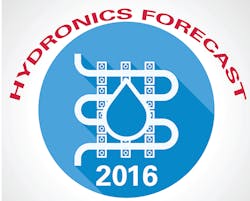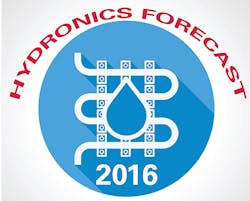2016 Hydronics forecast — betting on economy, and other critical factors
Let’s bet on the economy in 2016, in a positive way. “With continued improvement in the U.S. economy, especially with a strong new housing and construction market, the heating industry is projected to continue to grow in 2016,” said Shilai Xie, product manager for Heating Products, Bosch Thermotechnology Corp.
Reasons for optimism?
• Housing Starts: Single Unit New Home starts have rose +9 percent year over year and will continuously rise in 2016, 11.8 percent higher than 2015 based on the consumer trends. Multiple New Housing starts were 10.4 percent compared to last year, with slower growth expected in 2016.
“Indications are that better days are, indeed, ahead,” said Dale Stroud, senior director, Marketing/Offerings, Uponor. “This year we should be back over 1 million starts and next year, the experts are predicting about 1.3 million starts. And, even more improvement should occur in subsequent years.
“In spite of the heady days when starts were in the 1.8 to 2 million range, we really don’t want that to happen again,” added Stroud. “We simply don’t need that many starts. The last thing we want is to form another housing bubble, only to then again experience what happens when it bursts. On average, we should do about 1.5 to 1.6 million starts per year to satisfy demand.”
• Construction: 2016 Dodge Construction Outlook report predicts that total U.S. construction starts for 2016 will rise 6 percent to $712 billion, following gains of 9 percent in 2014 and an estimated 13 percent in 2015. Dodge Outlook Report predicts increased construction starts for housing, commercial and institutional building sectors, while public works is unchanged and electric utilities/gas plants decline.
According to the report, for 2016, the economic environment should support further growth for the overall level of construction starts. While short-term interest rates will be going up in 2016, given the expected rate hikes by the Federal Reserve, the increases in long-term interest rates should stay gradual. On the plus side, the U.S. economy continues to register moderate job growth, lending standards are still easing, market fundamentals for commercial real estate continue to improve, and more funding support is coming from state and local construction bond measures. Total construction starts in 2016 are forecast to advance 6 percent to $712 billion, with gains for residential building, up 16 percent; and nonresidential building, up 9 percent; while the non-building construction sector retreats 14 percent.
“We see continued growth in the commercial market,” said Dave Desjardins, product manager, Heating and Cooling, Viega. “The design trends we see coming in have shifted to commercially-based designs. There is a long sales cycle associated with these projects and we are seeing these projects break. The first quarter will be impacted by weather, but typically second and third quarter things start to pick up.”
And, continued Desjardins, “We are seeing more mixed system — partial radiant in new homes — as a popular option for residential projects. We also have seen more larger homes come in 2015 and see that trend continuing in 2016 based on home projections — new home starts and design trends coming into our design group.”
• Consumer confidence: Lower inflation had more customers optimistic in 2015. “In the past, we experienced some hiccups when we went through the Federal government shutdown and the debt limit debacle in Washington, but we are slowly working our way back to the magic number of 100 — as in $100 billion in yearly consumer spending. As consumers, we’re feeling better and better,” said Stroud.
• Enhanced technology: Smart technology with connectivity are also gaining a very strong foothold in the HVAC industry. With many manufacturers launching energy-efficient variable capacity products, more complex electronic control systems are deployed to provide feedbacks and precise control over the equipment. This technology provides better diagnostics and service tools for the contractors. For homeowners, it provides a much better comfort experience by integrating a system with customized temperature, humidity, air quality, and ventilation control. Homeowners can also enjoy the flexibility of live control and remote monitoring through a variety of connected consumer electronic devices.
• Hydronics replacement/upgrades: According to Viega’s Desjardins, the remodel market was strong in 2015 and he expects it to stay that way. “As the housing market grows, people are still upgrading and improving their current homes. Contractors are also providing radiant installations as a way to differentiate themselves,” said Desjardins.
Bosch product manager Xie continued to mention that the boiler and hydronic heating market will see a relatively modest growth, with stronger growth in the commercial replacement and upgrade segment. Although the residential renovation segment keeps its growth pace, penetration rate of hydronic systems for new construction is tempered by popularity of gas furnaces and heat pumps.
Both boilers and furnaces will continue the trend of shifting to condensing technology. Although natural gas prices remains low, previous volatility of energy prices and more stringent energy efficiency regulations will continue to push the migration towards high-efficiency condensing products.
Air-to-air heat pump growth will gather strength as the products gain more awareness. And gas furnaces will witness stronger growth in 2016 with strong residential housing market and low natural gas prices.
Government intervention
Speaking of energy-efficient regulations, the trend of increased regulation will continue. Following on the heels of the DOE’s commercial and industrial pump rulemaking was their focus on pool pumps and next up in 2016 will be circulators.
“All of these rulemakings and efficiency standards will certainly affect what manufactures will make and be able to sell in the future,” said Mark Chaffee, V. P. Governmental Affairs & Sustainability,Taco, Inc. “In the short term, it affects what manufacturers have in development, as great R&D expenditures are needed to comply with and stay ahead of the higher efficiency ratings and test/reporting requirements.”
“Incentives more than regulation will affect our industry in the short term,” added Chaffee. “State and utility program incentives will help make the move to ECM pumps easier financially for the contractor to try or switch to the new variable speed technology.”
Moreover, energy standards have driven commercial projects to radiant, said Desjardins. “We have seen more radiant cooling specifically being used to help achieve lower energy requirements.”
Finally, codes like the Uniform Solar Energy and Hydronics Code will help standardize things in the long run and allow radiant to be a more acceptable option in buildings, added Desjardins.

